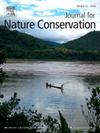Effects of land use and management on the structure and recruitment of an endemic palm tree (Attalea pindobassu Bondar) from the Brazilian semi-arid
IF 2.2
3区 环境科学与生态学
Q2 BIODIVERSITY CONSERVATION
引用次数: 0
Abstract
Attalea pindobassu is a palm tree endemic to the northern of the Espinhaço chain, found in the Caatinga domain, and it is a key non-timber forest product (NTFP) resource for the livelihood and income of people in the Brazilian semi-arid. We assessed the influence of environmental (soil features) and anthropogenic factors (type of land use and harvest intensity) on the natural regeneration and population structure of A. pindobassu, identifying the relative importance of these factors in the abundance of life stages. We sampled populations in 14 sites distributed in 63 plots, totaling 9.6 ha. Our sampling ranged from well-preserved sites, in natural areas (30 x 0.045 ha plots), to highly disturbed pastures in the agroecosystems (33 x 0.25 ha plots), covering an extensive area of the species distribution. Differences in the plot size occurred due to the conditions of land use, the density of individuals, and the spatial distribution in the sampled areas. We considered five life stages (seedling, sapling, juvenile, immature adult, and reproductive adults), in which seedling and sapling were fitted as regenerants. Recruitment failure occurs mostly in sites in agricultural and intensive pasture areas, in which habitats with a low rate of chronic anthropogenic disturbance showed a higher density of regenerants. In these habitats, marked by recruitment bottlenecks, populations are likely to become locally extinct. The fruit harvesting levels did not affect the density of regenerants. The social and economic importance of this species is an ecological asset that can foster the development of public policies, further promoting multiple sustainable uses of habitat remnants to ensure the application of the conservation strategy of under use.
求助全文
约1分钟内获得全文
求助全文
来源期刊

Journal for Nature Conservation
环境科学-生态学
CiteScore
3.70
自引率
5.00%
发文量
151
审稿时长
7.9 weeks
期刊介绍:
The Journal for Nature Conservation addresses concepts, methods and techniques for nature conservation. This international and interdisciplinary journal encourages collaboration between scientists and practitioners, including the integration of biodiversity issues with social and economic concepts. Therefore, conceptual, technical and methodological papers, as well as reviews, research papers, and short communications are welcomed from a wide range of disciplines, including theoretical ecology, landscape ecology, restoration ecology, ecological modelling, and others, provided that there is a clear connection and immediate relevance to nature conservation.
Manuscripts without any immediate conservation context, such as inventories, distribution modelling, genetic studies, animal behaviour, plant physiology, will not be considered for this journal; though such data may be useful for conservationists and managers in the future, this is outside of the current scope of the journal.
 求助内容:
求助内容: 应助结果提醒方式:
应助结果提醒方式:


